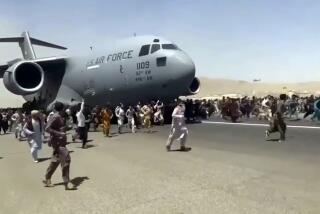Doyle McManus: A pivot point in Afghanistan
- Share via
In 1966, as President Lyndon B. Johnson was becoming ever more enmeshed in the war in Vietnam, a Republican senator from Vermont named George D. Aiken proposed an audacious alternative strategy. The United States, Aiken said, should declare victory and withdraw.
At the time, some believed Aiken was joking, but the senator was quite serious, and his proposal was considerably more subtle than it sounded. The United States, he said, should stop seeking objectives that were beyond its reach and focus on doing whatever was necessary to reach a negotiated solution it could live with.
There was an element of Aikenism in President Obama’s announcement Wednesday that the time has come to begin withdrawing U.S. troops from Afghanistan, and to do it a little faster than some of his generals wanted.
Even as U.S. forces continue to battle on the ground in Afghanistan, White House aides told reporters that the president’s decision was based on the success of U.S. and allied forces over the last 18 months. Reducing the number of troops reflects military progress, the White House said, not reverses.
But more important, Obama staffers were insistent in noting that the United States has limited goals in Afghanistan — far more limited than when we entered the war a decade ago. In those days, the administration of President George W. Bush hoped to turn the war-wracked country into a rapidly modernizing democracy.
Now, the goal is to make sure Afghanistan can’t be turned again into a staging ground for terrorism directed against the United States or Pakistan.
“It is important to note that defeating the Taliban is not the objective here,” Obama spokesman Jay Carney said this week. Instead, officials said, the objective is to negotiate a deal with the now-weakened Taliban, one that could see some of the Islamist insurgents return to a role in Afghanistan’s government.
A White House official said Obama hoped that Americans would see Wednesday night’s speech as a “pivot point” in the almost 10-year-old war — as the moment when the United States shifted from increasing the number of its troops in Afghanistan to bringing them home.
The timetable presented by the White House on Wednesday covered only about a third of the roughly 100,000 U.S. troops now in Afghanistan: the 33,000 who were sent in the “surge” Obama ordered at the end of 2009. But the official said the president wants withdrawals to continue even after the surge troops are out.
That calendar is a bit quicker than U.S. military commanders had wanted. Military officials had asked for most of the surge troops to remain until the end of 2012, to keep them on the ground through the entire “fighting season.” Instead, Obama decided that the surge troops should be out by September 2012.
That apparent conflict — and the timetable’s coincidence with the presidential election campaign, which will be in full swing next September — was the focus of much of the initial reaction to Obama’s move.
In fact, though, the September withdrawal date is roughly what Obama signed up for in December 2009, when he agreed to the military’s request for a surge that would last about 24 months at full strength. Underlying the president’s rebuff to the generals’ request for more time was his desire to make it clear that the decision to draw down was serious and immutable.
For all that, though, this withdrawal timetable is no rush for the exits. Under Obama’s calendar, there will still be about 67,000 U.S. troops in Afghanistan in the fall of 2012. That’s twice as many as were in the country when Obama entered the White House.
And U.S. officials are talking increasingly of a long-term commitment of military trainers, advisors and others that would remain for many years. The commander of the U.S. training mission in Afghanistan, Lt. Gen. William B. Caldwell, said this month that his mission of building the Afghan army and national police would take “until about 2016, 2017.”
Will this plan work? It’s far too early to say, of course. The parts of the puzzle that are most susceptible to applications of U.S. military power — tracking down and killing Taliban leaders, and training Afghan army troops — appear to be going well. The non-military parts — nudging Afghanistan’s civilian government toward more efficiency and less corruption, persuading Taliban leaders to negotiate an end to the war — don’t.
Obama’s decision is a gamble, but so are many decisions in war. If Afghans on both sides conclude that the United States is leaving the battlefield, and the Taliban resurges, the president’s choice this week won’t look brilliant. But if the U.S. military’s assessments of the Taliban are accurate, that’s not likely to happen.
So yes, it’s a pivot point, both in U.S. strategy and in the politics of the war at home. From now until election day in 2102, Obama can (and doubtless will) cast our progress in Afghanistan in a new, more hopeful narrative. The late Sen. Aiken would have recognized the approach: We’ve redefined our goals, we’re winning, and we’re getting out.
More to Read
Sign up for Essential California
The most important California stories and recommendations in your inbox every morning.
You may occasionally receive promotional content from the Los Angeles Times.














